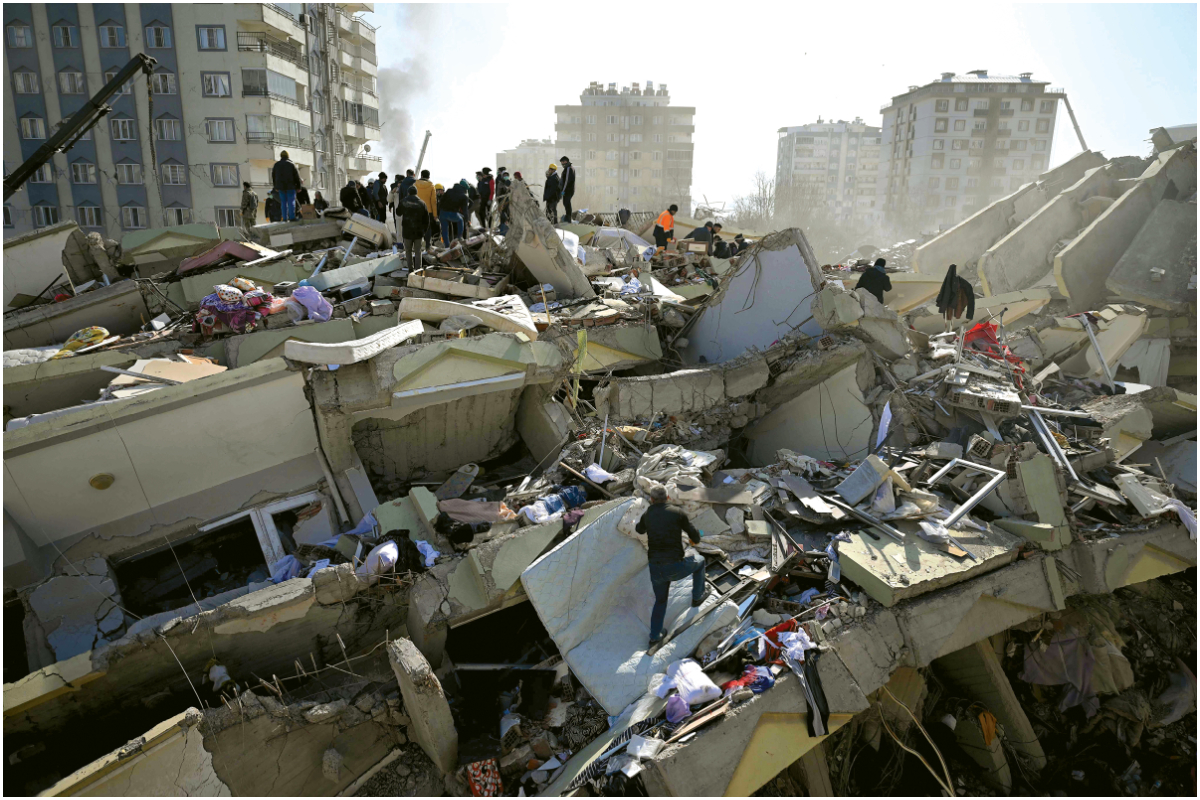
Help first, don’t criticise
Offering moral and logistical support is far more important than amplifying allegations centred on Türkiye’s construction boom
ANKARA: Türkiye’s southeastern provinces were jolted by twin earthquakes with staggering 7.7 and 7.6 magnitudes leaving a massive trail of death and destruction. Türkiye’s disaster management teams scrambled to the areas hit by the calamity, but the enormity of it was so overwhelming that Ankara immediately announced the Level 4 alert, seeking outside help.
Rescuers were scouring debris more than 100 hours (till February 10) after a massive earthquake hit Türkiye and Syria on February 6, killing at least 21,771 people (till February 10) in one of the region’s worst disasters of a century. In Türkiye, at least 18,340 people have been killed and 74,242 others injured by two strong earthquakes that jolted southeastern Türkiye. A total of 80,863 people were evacuated, Türkiye’s disaster management agency says.
No stranger to tremors, Türkiye is among the 10 most earthquake-prone countries in the world. February 6 twin tremors are by far the most destructive and apocalyptic ones the country has experienced since 1939. At least ten provinces, as large as Cuba, are directly affected, with a population of 13.5 million reeling from the disaster. The neighbouring northern Syria is suffering too.
More than anything else, Türkiye and Syria need humanitarian support. More than rhetoric, we need action – rescue teams, technical support, and any logistical assistance to our foreign missions in organising aid. But unfortunately, a section of Western media has started mudslinging the Turkish government at a time when the country is neck-deep busy supervising search and rescue missions across the country.
One particular allegation floating in foreign media organisations is centred on the construction boom witnessed in the past 20 years of President Recep Tayyip Erdogan’s governance. At a time when successive aftershocks spread fear and panic in the disaster-hit region, Western media organisations are publishing reports and op-eds claiming that Türkiye’s “construction-driven” economic growth is largely to be blamed for the soaring death tolls in quake-hit areas. The government is being accused of turning a blind eye to upholding crucial building and safety standards. Such allegations are being played on a loop.
Although all the collapsed buildings must be investigated and stakeholders punished if they are found guilty of violating the construction norms, the government should be given space to focus on the search and rescue operations and implement contingency plans such as housing tens of thousands of people who lost their homes in the past four days as well as providing healthcare and other essential supplies to the affected populations.
Amplifying critical voices during a natural disaster can be perceived as an ugly attempt to politicise the crisis. From geologists to world leaders, including US President Joe Biden, every rational mind can see how unprecedented and enormous is the scale of twin quakes. The second earthquake that occurred in close proximity to the first one and with an equally high magnitude makes this disaster a rare phenomenon in recorded seismic history.
Türkiye is not the only country in the world with a mass of constructions that are either old or may not pass the earthquake safety test. The US has a dense mass of unsound buildings too. For instance, take Los Angeles: its municipality has no records of how many buildings across the city are non-ductile. In 2013, an independent analysis pointed out that at least 1000 buildings in LA city and hundreds more in other counties were prone to collapsing if ever a high-magnitude earthquake occurred.
In light of Türkiye’s double tremors, there is a lot to process. Peculiarities such as the multiplicity of the main fault lines and the seismic rupture at a shallow depth have made this disaster one of the worst in the region. The impact was so hard that roads and motorways were cracked open and buildings crashed like a pack of cards. Even the 2000-year-old Gaziantep Castle faced severe damage despite being renovated several times in recent history.
While the focus at this stage must remain on rescuing as many people as possible and retrieving the bodies underneath the rubble, the government must probe the buildings to find out where the construction laws were violated and identify the people responsible for bypassing the norms. But at the same time, media organisations, especially the ones operating from Western countries, should abstain from exploiting a calamity of this scale for mere political opportunism.
Courtesy: TRT World
The banality of evil
Charlie Hebdo mocks victims of the devastating earthquake
There are some things that are so patently wrong and grotesque that it takes a particular breed of soulless, hateful human to think it acceptable – or even funny. Of course, I am here referring to the tasteless French satirical magazine Charlie Hebdo’s recently published cartoon that made fun of the thousands of Turkish and Syrian victims who perished or were made homeless and destitute in the aftermath of the deadly earthquakes that struck the region, with its epicentre in Türkiye’s southern city of Kahramanmaras.
Naturally, and very appropriately, this action has been met with widespread criticism and outrage, as it is obviously understood by all and sundry to be insensitive, inappropriate, and motivated by racist and anti-Muslim tendencies that are deeply ingrained in French society.
France’s history of Muslim hatred
First, it is important to note the aftermath of French colonialism and the long history of racist attitudes towards Muslims, even French citizens, in France itself. Imperial France once ruled over vast territories in North Africa and the Middle East, and its legacy of racist colonialism has left deep wounds that have yet to heal. This includes entrenched racism and prejudice against Muslims, many of whom still face discrimination in France today — discrimination that is promoted at the very top of the French government by none other than President Emmanuel Macron.
Syria was directly ruled by the French, who spent more than a quarter of a century between 1920-1946 brutalising the Syrian people and attempting to annihilate their sovereignty and right to self-determination. This history of colonialism and racism has filtered into today’s modern French society, dehumanising Muslims, and making magazine editors such as those who work for Charlie Hebdo think that this sort of despicable stunt is appropriate. It has also made the Turkish and Syrian earthquake victims particularly vulnerable to this kind of insensitive and hurtful “satire” that seeks to gain cheap laughs out of the still flowing wounds of the innocent.
Moreover, the magazine’s actions are obviously a manifestation of rampant hatred for Muslims. The rising anti-Muslim sentiment is a growing problem in France and many other Western countries, characterised by a totally irrational fear and hatred of Islam and Muslims.
This fear and hatred is often fuelled by negative stereotypes and misinformation, and it is a major contributor to the marginalisation and discrimination faced by Muslims, not only in France but even further afield.
By making fun of the Turkish and Syrian earthquake victims, Charlie Hebdo is not only perpetuating these negative stereotypes, but it is also contributing to the already widespread anti-Muslim hatred in France and beyond. Take, for example, the caption referenced in the caricature: the cartoonists take particular glee at the destruction wrought against largely Muslim people, and explain how they “didn’t even need to send tanks”. In other words, they are giddy with delight to see destruction inflicted upon Muslims the likes of which a devastating war would bring.
Cry for France, but laugh at Muslims
Making fun of people in the aftermath of a tragedy is never acceptable, regardless of their religion or ethnicity. For example, when Charlie Hebdo itself was attacked in 2015, Turks, neither at state level nor even on a social level, did not engage in wholesale mockery. To the contrary, it dispatched its top diplomat to Paris in a show of solidarity with France against terrorism.
The victims of earthquake have suffered great loss and trauma, and they deserve to be treated with dignity and respect. Making fun of their suffering is not only vile, but it also sends a message that their lives and experiences are not worth valuing or respecting, and neither are those of their families and loved ones.
This kind of message is particularly harmful in the context of French and wider Western society that is already deeply divided along racial and religious lines.
Satire is a powerful tool, and it can have a profound impact on the people it targets, as well as public perceptions. Satire is often used to challenge power and to expose injustice and hypocrisy. However, when satire is used to make fun of people who are already marginalised and vulnerable, it only serves to further harm them. This is especially true when the people being targeted are the victims of a tragedy, as they are already in a state of extreme vulnerability and distress, and punching down on the vulnerable is never a good look, not to mention woefully immoral.
Then again, this is hardly new to Charlie Hebdo, a truly disgusting publication that even thought it was both appropriate and funny to make jokes about Italian earthquake victims as different types of pasta in 2016. Also in 2016, who can forget how the magazine showed they lack anything remotely resembling humanity and decency when they made fun of the corpse of two-year-old Alan Kurdi, a Syrian refugee who drowned in the sea as his family attempted to escape war and bloodshed.
On the flip-side, Charlie Hebdo wanted the entire world to cry with it and France when they were subjected to attack, but feel it is appropriate to plumb moral depths that include laughing at death and destruction afflicting Muslims.
When anyone is that morally bankrupt, I think it is safe to say that magazines like Charlie Hebdo are nothing more than a cheap rag designed to get laughs out of the likes of far-right fascists who revel in Muslim blood.
While Kahramanmaras is literally named for its heroism — a virtue it currently has on full display and that is replicated across the entire disaster zone — Charlie Hebdo will forever go down in history for its villainy. And, despite all the pain we are all feeling, that is an equation I can live with.
Courtesy: TRT World
The author is an award-winning academic and writer, with a specialism in Middle Eastern strategic and security affairs
Emergency aid and support
- Many governments and international organisations have responded with offers of support and will ready to help more to Turkey and Syria.
- China announced its first batch of 40 million yuan ($5.9 million) of emergency assistance to Turkey and dispatched rescue teams to help save lives and provide assistance to Syria. A Chinese earthquake rescue team arrived in Turkey’s Adana. The team of 82 members and four search dogs, brought 20 tonnes of supplies and equipment.
- The United States announced an initial $85 million package for emergency relief. The US Agency for International Development said that the funding will go to partners on the ground “to deliver urgently needed aid for millions of people” including through food, shelter and emergency health services. The funding will also support safe drinking water and sanitation to prevent the outbreak of disease, USAID said in a statement.
- Assistance in Syria is going through local partners as the United States refuses to deal with Syrian President Bashar al-Assad as Washington demands accountability over abuses during the brutal civil war.
- Russia’s emergencies ministry said two IL-76 aircraft with 100 rescuers were ready to fly out to Turkey if required. President Vladimir Putin sent messages to Turkey and to Syria, where Russian troops have been supporting the Syrian military, expressing condolences to the presidents of both nations and offering support.
- World Bank to provide Turkey $1.78 billion in aid to Turkey to help relief and recovery efforts. “We are providing immediate assistance and preparing a rapid assessment of the urgent and massive needs on the ground,” said World Bank President David Malpass in a statement.
- Saudi Arabia ordered an air bridge to provide aid and organised a campaign through its ‘Sahem’ platform to help in Turkey and Syria.
- The UAE said it would set up a field hospital in Turkey and dispatch search and rescue teams to Turkey and Syria.
- The UK government said 76 British search and rescue specialists with four search dogs and rescue equipment had been sent to Turkey and a British emergency medical team would assess the situation.
- Spain was sending an A400 military plane with firefighters and equipment, along with an Airbus A330 with civil defence staff to work with rescuers.
- The Qatar government said it was operating relief flights to Turkey to transport search and rescue teams along with vehicles, a field hospital, tents and other supplies, Qatar’s state news agency reported. Qatar-funded Qatar Charity said it was distributing 27,000 hot meals in the Turkish city of Gaziantep. The group allocated $6 million for the first stages of its response.
- Pakistan said it was sending two C-130 planes with relief supplies and 36 search and rescue personnel.
- The Italian Roman Catholic Church allocated 500,000 euros ($537,800) for emergency aid.
- Germany’s federal civil protection agency could provide camps with emergency shelters and water treatment units and that it was preparing relief supplies with emergency generators, tents and blankets.
- Canadian PM Justin Trudeau pledged C$10 million ($7.5 million) in immediate aid to Turkey and Syria, and said Canada would continue to provide support as the situation evolved.
- Australia said it would provide A$10 million ($7 million) in aid and deploy an urban search and rescue team of up to 72 people to Turkey.
- Switzerland has sent about 80 Swiss Rescue experts and eight search dogs to Turkey.
Miracles and concerns
ANKARA: World leaders have expressed concerns over the deadly earthquakes.
- “My heart goes out to the people of Turkey and Syria in this hour of tragedy,” said UN Secretary-General Antonio Guterres in a statement. “The United Nations is fully committed to supporting the response. Our teams are on the ground assessing the needs and providing assistance.”
- Chinese President Xi Jinping on Monday sent messages of condolence respectively to Turkish President Recep Tayyip Erdogan and Syrian President Bashar Al-Assad over the tragic earthquakes in the two countries.
- Erdogan also announced a three-month state of emergency across 10 provinces.
- US president Joe Biden says “I am deeply saddened by the loss of life and devastation caused by the earthquake in Turkiye and Syria. I have directed my team to continue to closely monitor the situation in coordination with Turkiye and provide any and all needed assistance,” the president tweeted from his official account.
- “Dear Mr. President, please accept my deep condolences over the numerous human casualties and widespread destruction caused by the powerful earthquake in your country,” the Russian leader said in a telegram to Erdogan.
- Saving lives
- A radar system developed by the Turkish state-run defence company STM is saving lives in the earthquake-ravaged areas of Türkiye. The through-the-wall DAR radar system can locate people through mounds of debris. The teams pulled out more than 20 earthquake victims alive from collapsed buildings through DAR radar system.
- An Uzbek rescue team pulled a man alive from under the rubble of a collapsed building after 100 hours. Naim Bayasli, 32, was rescued from under the rubble of a building in Hatay province.
- Turkish teams rescued 66-year-old Murat Vural in the province of Gaziantep, Islahiye district, 103 hours after the first of two powerful earthquakes. Vural was carried out of the debris after 10 hours of work by members of the National Medical Rescue Team (UMKE) and police. This came two hours after a similar rescue story in Hatay province, where a miner crew from Zonguldak province saved a mother, Ihlas Ayaz, and her son Yigit.
- UMKE and police teams in the Elbistan district of Kahramanmaras province saved the life of Mustafa Sahin Sami 102 hours after the first quake. The teams worked 12 hours to rescue the 33-year-old man from the rubble of a seven-story building.
- Also in Kahramanmaras, a 15-year-old girl was rescued by Azerbaijani teams. The Syrian-origin Ayse Mustafa was saved after 103 hours.
- Three-and-half-year-old Zeynep Ela Parlak was also pulled out of the rubble in Hatay, also 103 hours since the initial tremor.
- Sixty-year-old Eyup Ak was pulled out alive from the rubble of a collapsed building, in another miraculous rescue in southeastern Türkiye.
- Rescue teams pulled alive two sisters from the rubble, more than four days after powerful earthquakes hit southeastern Türkiye. Ayfer, 15, was rescued in Kahramanmaras province after being trapped for 99 hours. Her 13-year-old sister Fatma was also saved two hours later, and both were given medical attention.
- A 30-year-old civil engineer was pulled out alive from the rubble of a collapsed building on the fifth day.
Courtesy: TRT World
Catch all the The Globe News, Breaking News Event and Latest News Updates on The BOL News
Download The BOL News App to get the Daily News Update & Live News.
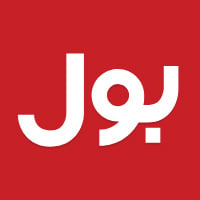





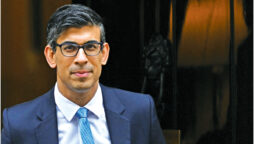
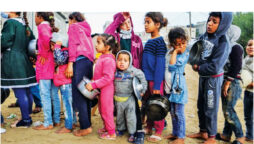
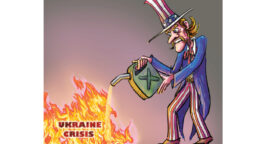
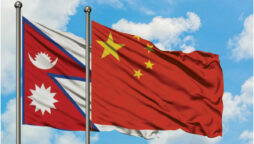
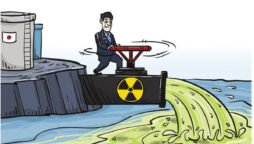

 Read the complete story text.
Read the complete story text. Listen to audio of the story.
Listen to audio of the story.